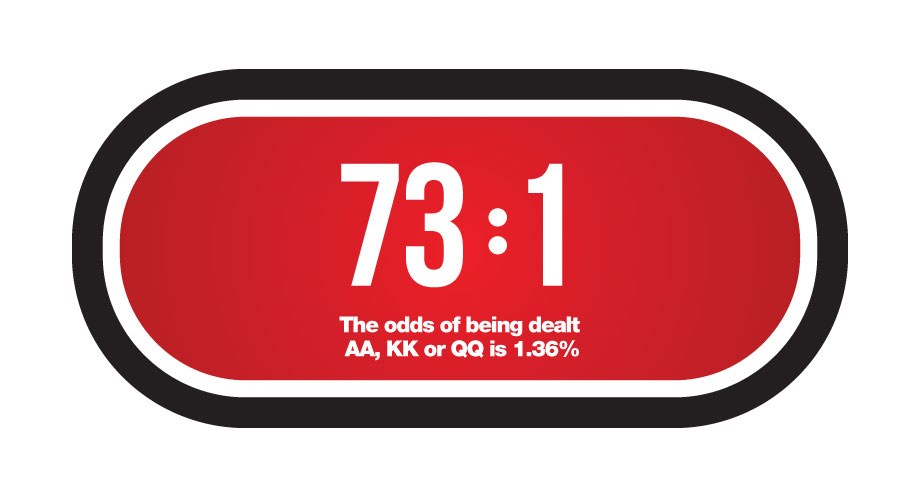Poker starting hands are absolutely paramount to understanding how to play poker, and we’re here at MacPoker.com to take your online and live poker game to the next level. We’ll go through a range of poker starting hands and recommend an action for each.
7 Types of Poker Starting Hands
1. Premium Pocket Pairs
Examples: A-A, K-K, Q-Q
Recommendation: Premium pocket pairs should be played with a raise pre-flop in any position and aggressively thereafter. If you’re in early position, raise it up. If you’re in middle position, open-raise or come over the top of another bet. Similarly, late position players should raise it up. Play these hands aggressively pre-flop; we can’t stress that enough.
You’ll very rarely pick up premium pocket pairs, so taking full advantage of the opportunity is of the utmost importance. Some players would advocate slow playing premium pocket pairs, but in our opinion, doing so will set you up for failure in the hand, especially at the lower stakes. Play premium pocket pairs with authority.

2. High Broadway Hands
Examples: A-K, A-Q, K-Q
Recommendation: Similarly to premium pocket pairs, it’s important to play the higher-end Broadway hands with authority. Calling an all-in with one of these hands will likely set you up to be in a race, at worst, while pushing with one of these hands will force your opponents into tough situations. This assumes, however, that you’re comfortable racing with a significant chunk of your stack on the line.
The beauty of hands like A-K and A-Q are that, at lower levels of play, you’ll often be up against hands like A-9 and A-10. Against these, you’ll be a significant favorite pre-flop. If the flop were to come ace-high, chances are that the money is going into the middle and you’ll be ahead. Hands like A-J and K-J are a little dicier, as calling and pushing should ultimately depend on your opponents’ hand ranges.
3. Middle Pairs
Examples: 10-10, 9-9, 8-8, 7-7
Recommendation: Middle pairs should be played with caution. If you want to race for your tournament life, then pushing and calling with a hand like pocket eights will mean that you’ll survive about half of the time. Instead of facing a hand like A-Q, which is a standard race situation, you might find yourself up against pocket jacks or pocket queens, which means that you’re a 4:1 underdog.
The advantage of these hands is that they’re a favorite over lower suited connectors like 7-8, 6-7, and 5-6 and are 4:1 favorites over hands like pocket fours and pocket fives. Middle pairs often are the demise of players, so exercise caution. 3betting and 4betting with a hand like pocket nines will often land you in hot water. Even calling a 3bet or 4bet with a middle pocket pair is not advisable. Instead, save yourself money and muck.
4. Low Broadway Hands
Examples: Q-J, Q-10, J-10
Recommendation: Unless you’re the player opening the action, avoid these hands. The problem with getting involved with a hand like Q-10 is the dilemma you face when the flop comes queen-high or ten-high. If the flop were Q-8-3, are you ahead? It’s entirely possible, depending upon your reads of your opponents, that someone else at the table could have K-Q or A-Q, in which case you’re dominated and probably going broke. If the flop came 10-high, you only have the third best kicker and would be dominated by hands like K-10 and A-10. It’s best to be the aggressor rather than call off your stack with these types of hands.
5. Low Pocket Pairs
Examples: 2-2, 3-3, 4-4
Recommendation: If you can see a flop for cheap with a hand like pocket threes, then by all means call to see if you can flop a set. However, calling raises out of position and calling 3bets is a poor idea with a low pocket pair. Limping pre-flop is your optimal strategy with low pocket pairs, with the goal of flopping a set. Flopping anything else means that you should be check-folding.
6. Junk Hands
Examples: 6-2, 3-7, 4-8
Recommendation: Unless you’re in the blinds, these hands are auto-folds. There’s no reason to waste your hard-earned chips playing hands like 5-10 or 9-3. I know you’re about to say that Doyle Brunson won back-to-back World Series of Poker Main Events with 10-2, a junk hand. While that’s true, the odds of the same fate happening to you are quite slim. Buy yourself a lottery ticket instead.
7. Connecting Cards
Examples: 7-8, 8-9, 9-10
Recommendation: Connecting cards, especially ones that are of the same suit, can be powerful hands in poker. It’s generally advisable to play these hands in position, as they can lead to straight and flush draws after the flop. Then, staying in the hand ultimately depends on your pot odds on bets. If your connectors miss on the flop, then get out of the way. There is very little upside to carrying on a bluff on further streets. Instead, if you hit air on the flop, bow out. Your bankroll will thank you.

Comments are closed.